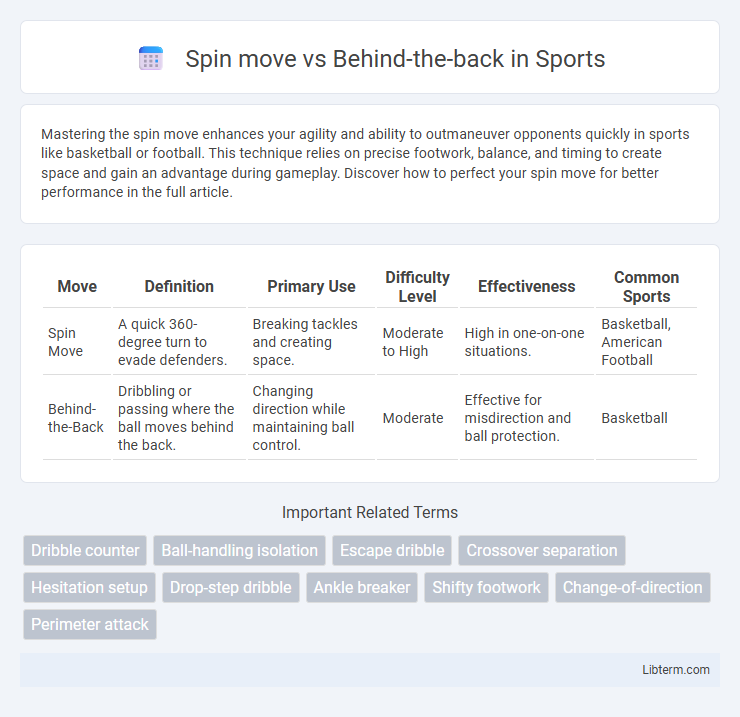Mastering the spin move enhances your agility and ability to outmaneuver opponents quickly in sports like basketball or football. This technique relies on precise footwork, balance, and timing to create space and gain an advantage during gameplay. Discover how to perfect your spin move for better performance in the full article.
Table of Comparison
| Move | Definition | Primary Use | Difficulty Level | Effectiveness | Common Sports |
|---|---|---|---|---|---|
| Spin Move | A quick 360-degree turn to evade defenders. | Breaking tackles and creating space. | Moderate to High | High in one-on-one situations. | Basketball, American Football |
| Behind-the-Back | Dribbling or passing where the ball moves behind the back. | Changing direction while maintaining ball control. | Moderate | Effective for misdirection and ball protection. | Basketball |
Introduction to Basketball Ball-Handling Moves
Spin moves and behind-the-back dribbles are fundamental basketball ball-handling techniques that enhance a player's ability to navigate defenders. The spin move involves a 360-degree turn while maintaining control of the ball, creating space for driving or shooting opportunities. Behind-the-back dribbles offer deceptive ball control by shifting the ball across the body, enabling quick direction changes and protecting the ball from defenders.
What Is a Spin Move?
A spin move is a basketball maneuver where the player quickly rotates their body 360 degrees while dribbling to evade a defender and create space for a shot or pass. This technique relies on sharp footwork and body control to maintain balance and speed during the rotation. Unlike the behind-the-back dribble, which focuses on ball protection and misdirection, the spin move emphasizes dynamic movement and sudden directional change to break past opponents.
Understanding the Behind-the-Back Move
The Behind-the-Back move in basketball requires precise hand-eye coordination and body control, allowing players to protect the ball while dribbling under defensive pressure. Mastering the technique involves keeping the dribble close and using the off-hand to swiftly switch the ball behind the back, confusing defenders and creating space. Compared to the Spin move, the Behind-the-Back offers greater versatility for directional changes and is less predictable when executed with speed and fluidity.
Key Differences: Spin Move vs Behind-the-Back
A spin move involves a player rotating 360 degrees to evade defenders, using momentum to create space and maintain ball control, making it effective for quick directional changes. In contrast, the behind-the-back dribble hides the ball behind the player's body to protect it from defenders while facilitating smooth transitions between hands. The spin move emphasizes rotational agility and explosive burst, whereas the behind-the-back prioritizes ball security and subtle deception.
Benefits of Using Spin Move
The spin move offers a powerful advantage by enabling players to quickly change direction and evade defenders with fluid rotational momentum, enhancing offensive agility. This technique maximizes speed retention during transitions, making it harder for opponents to anticipate and react effectively. Utilizing the spin move increases scoring opportunities by creating separation and opening clear lanes to the basket.
Benefits of Using Behind-the-Back Move
The behind-the-back move offers enhanced ball control by shielding the ball from defenders more effectively than a spin move, allowing for safer dribbling in tight spaces. This technique improves court vision and passing angles, enabling players to create scoring opportunities without committing turnovers. Mastery of the behind-the-back move increases offensive versatility and unpredictability, making it a valuable skill in high-pressure game situations.
Situational Effectiveness: When to Use Each Move
Use the spin move when confronting defenders directly to exploit their momentum and create space quickly in one-on-one situations. Choose the behind-the-back dribble in tight spaces or during transitions to maintain ball control and disguise your next direction, especially when facing aggressive defenders. Assess defensive positioning and game tempo to select the optimal move that maximizes ball retention and scoring opportunities.
Common Mistakes and How to Avoid Them
Common mistakes in executing the spin move include losing balance and failing to maintain control of the ball, while behind-the-back dribbling errors often involve improper hand placement and insufficient wrist action. To avoid these issues, players should practice foot positioning and core stability drills for the spin move, and develop strong hand-eye coordination and fluid wrist movements for behind-the-back techniques. Consistent repetition with slow, controlled motions enhances muscle memory and reduces turnovers during competitive play.
Drills to Master Spin and Behind-the-Back Moves
Mastering spin moves and behind-the-back dribbling requires focused drills such as cone weaving and controlled pivoting to improve agility and ball control. Repetitive practice of spin spins around stationary defenders enhances body coordination and balance, while behind-the-back drills like figure-eight patterns with a basketball increase hand speed and dribbling precision. Incorporating resistance training with dribbling exercises further develops muscle memory and sharpens execution during game situations.
Choosing the Right Move for Your Playstyle
Spin moves offer explosive agility and are ideal for players seeking quick directional changes to evade defenders, maximizing speed and momentum in tight spaces. Behind-the-back dribbles provide deceptive ball control and are best suited for players emphasizing finesse and maintaining close proximity to defenders while protecting the ball. Selecting the right move depends on whether your playstyle prioritizes raw speed and power or precision and unpredictability in ball handling.
Spin move Infographic

 libterm.com
libterm.com